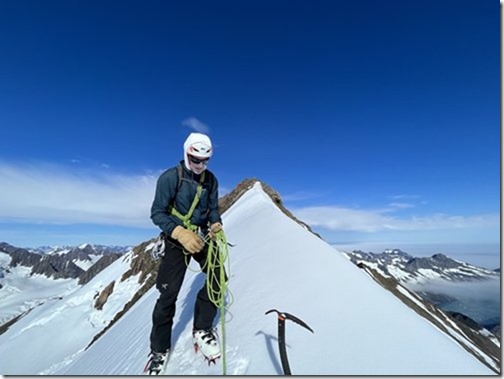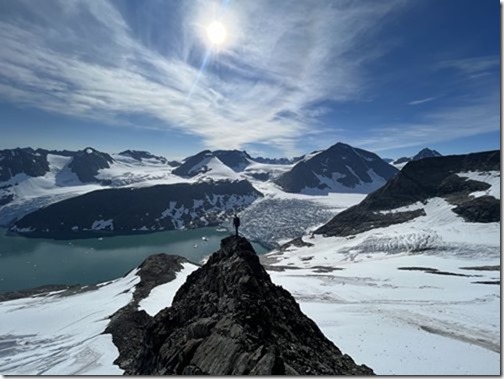Unclimbed Peaks and Floating Wellies

|
66:48.04 N 34:06.06 W
The area around Poulsen fjord has proved to be an excellent one with the entire expedition team active. We have been blessed with stable weather here, though experience occasional fog and icing on the deck in the mornings. Ice and icebergs have been a continual feature of this trip. We have watched as the fjord has filled then emptied, then filled again with grease ice, bergy bits, growlers and Umiak size bergs. Some of these drift around slowly and some approach with magnetic menace and require evasive action from bow thrusters and bamboo poles. We have picked one of the clearest parts of the fjord though, and have enjoyed mostly peaceful nights. Poulsen Fjord runs roughly North/South with a glacier calving into the sea at its North end. Alpine, rocky and glacial peaks surround it. We have found access to some of them and the pace of exploration has increased as the expedition end looms. On Wednesday Tim and Gringo set off up one of the obvious peaks with a hanging serac/glacier and an access couloir they had spotted the evening before. Mike and Alastair followed later but had not been on the previous recce. We have sometimes experienced morning fog here and both teams were enveloped in it. At around 700m Tim and Gringo burst out of the fog to a classic inversion with a vista reaching 100’s of miles. Mike and Alastair had taken a different line in the poor visibility and were stopped by complicated crevassing, returning to Umiak to fight another day. After some steep and complicated glacial terrain Tim and Gringo reached the 1270m summit of a probably unclimbed peak. Not wanting to descend the softening, steep snow they descended the SW rocky ridge. This was delightful and easy until it was frightening and loose. 2 abseils and some very delicate climbing were needed to get off it. (peak 1270m SW face AD- and SW Ridge AD+). Chris in the meantime ascended by ski the obvious slopes to a col/couloir at 780m above the anchorage. He had waited until the afternoon to time his descent on ‘corn’ or ‘Spring snow’ enjoying some great turns. It was on this day that ‘wellygate’ occurred. We leave our muckboots, lifejackets and sometimes a ‘survival barrel’ (in case of being cut off) on the shore when we go out on our excursions. The mountaineers amongst us have relied upon the expertise of the sailors (professional Yachtmasters no less) to gauge tide ranges so it came as a surprise to see various wellies and inflated lifejackets floating out in the middle of the Fjord amongst the icebergs. They were all recovered and we have promised not to talk about it again. The next day Olly, Chris, Mike and Alastair set out gaining, by ski, the main glacial system which ultimately leads to the icecap itself. We are learning that everything here is further away, higher and simply bigger than it looks. I think this may be down to scale and air quality but it really is a phenomenon. Mike and Alastair went for an odyssey up the main calving glacier returning at the end of the day with reports of difficult or serious terrain. Olly and Chris had a big day covering a lot of ground and accessed a completely different glacier system draining from the icecap. They climbed a snow dome peak 1370m abutting a larger peak and enjoyed a steep ski down its South face (South Face peak 1370m PD) returning late that evening. Tim and Gringo took advantage of the proximity of a group of cliffs (Poulsen Fjord Crag) next to the anchorage and went rock climbing above icebergs on good gneiss (Sledge Patrol HVS 5A, 4B). Yesterday was another active day with Chris and Olly climbing another possible unclimbed peak. This was accessed by some steep and exposed skinning (climbing on skis with skins on) and ski crampons. They had to wait for the snow to soften again for both the ascent and descent. Peak 1080m PD+. Tim and Gringo went to further explore the area beyond peak 1370m drawn by the sinuous snow arete leading to an obvious major peak. This proved to be similar in difficulty to the Rochefort Arete in the European Alps and involved delicate balancing on corniced edges. Finally the summit was reached after 6 hours with an incredible vista all the way in to the interior ice cap. (West Ridge Peak 1490m AD). As we now start to plan for the return leg it’s been good to reflect upon the teamwork and sharing of skills during the expedition. Teaming mountaineers and sailors has been one of the most enjoyable dimensions for me personally.
TB
|

